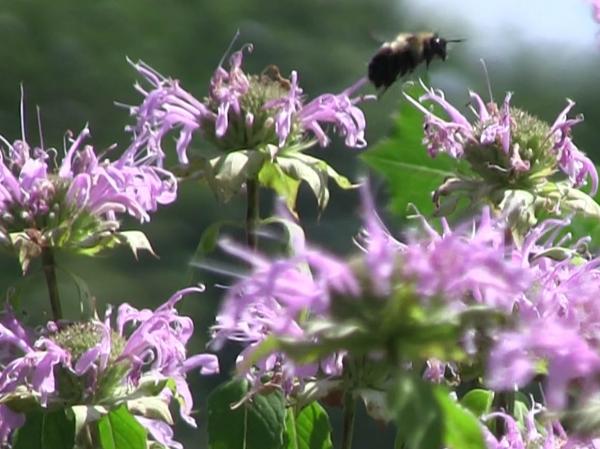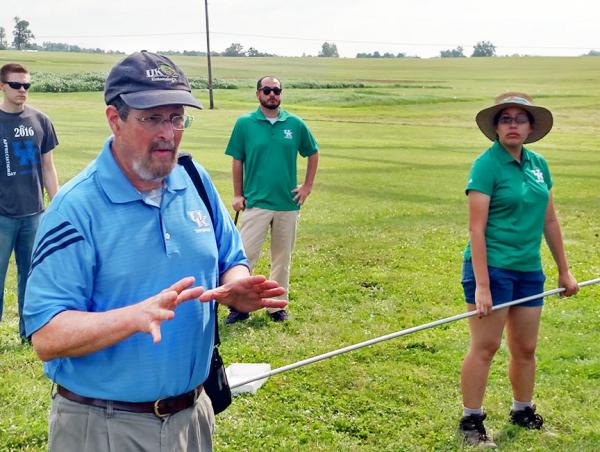The first Operation Pollinator plots in the United States were established under the eye of entomologist Dan Potter, Ph.D., at the University of Kentucky. So when it was time for the next phase of pollinator research, one that examines their relationship with certain pesticides, it was only fitting that it too takes place under Potter.
 Bernadette Mach, a doctoral candidate under Potter, has a couple of research projects under way in Lexington. She is collecting data to produce what might be the first science-based list of pollinator friendly plants, and her work on how those insects are affected by neonicotinoid-class insecticides could go a long way in determining the future of pest management in turf and ornamentals.
Bernadette Mach, a doctoral candidate under Potter, has a couple of research projects under way in Lexington. She is collecting data to produce what might be the first science-based list of pollinator friendly plants, and her work on how those insects are affected by neonicotinoid-class insecticides could go a long way in determining the future of pest management in turf and ornamentals.Earlier this year, the U.S. Environmental Protection Agency opened a review of all neonicotinoid insecticides, meaning the entire class could be at risk. Although that group of pesticides is believed to be one of the factors contributing to bee decline, no science-based research has been conducted in that area, until Mach's work that is being conducted on stations at UK, throughout Lexington and around Kentucky.
Her work includes timings and rates applied mostly to ornamentals, but could affect how other pests are managed, including emerald ash borer and white grubs in turf, too, Potter said.
"The EPA is making decisions as we speak as to whether they are going to cancel the registrations of these products, and we are trying to get real data whether these things do or do not pose a hazard," Potter said during UK's recent field day at the A.J. Powell Turfgrass Research Center. "We think with the right safeguards and timings we can continue to use these things without having much of an impact on the bee issue.
"When we lose these things, we won't have anything left for emerald ash borer control, and we'll only have Acelepryn for grubs, so we would like to hopefully keep these tools."
According to the University of Florida, honey bee populations have been steadily decreasing in the United States since the 1940s. Several factors are at play, including harsh winter conditions, varroa mite infestations and colony collapse disorder, a phenomenon that occurs when mass numbers of worker bees inexplicably fail to return to their hives. It is believed that some pesticides, particularly neonicotinoids, have played a role in CCD.
"We are hoping to find a happy medium so we can provide an environment that is friendly to bees and also one in that we are not overrun with white grubs, Japanese beetles and emerald ash borer," Mach said.
That relationship between bees and neonicotinoids came to a head in 2013 when more than 25,000 bumblebees from an estimated 300 colonies died after an application of dinotefuran to flowering linden trees in an effort to control aphids at a shopping mall near Portland, Oregon.
So far, Mach's studies have confirmed that pollinators tend to lose their way home when exposed to low doses of neonicotinoids. The science beyond that, she said, is, right now, anyone's guess.
"Neonicotinoids have gotten a lot of heat the past couple of years because of the threat they pose to bees," Mach said. "This really concerns the public, and this is a valid question.
"There has not been a lot of research on realistic scenarios," she said. "When they are exposed to neonicotinoids in the lab, they don't navigate real well. They might die in high enough doses, but we don't what that is yet, or what they might encounter in treated areas."
Mach's work also is investigating which plants and flowers are the most friendly for bees. She wants to go beyond anecdotal evidence to provide a science-based list of bee-friendly plants.
 There are more than 20,000 species of bees found around the world, about 4,000 of which can be found in the United States, according to the USDA.
There are more than 20,000 species of bees found around the world, about 4,000 of which can be found in the United States, according to the USDA."You can look on labels that say plants are bee friendly, but they're not backed by any data," she said. "It's based on someone going into their back yard and saying, 'hey, there's a bee on that plant, so it must be good for bees.' There is no quantifiable number to determine how attractive it is or what types of bees it is attracting."
So far, her work has identified more than 16,000 individual bees on nearly 100 plant species around Lexington.
Establishing areas that attract pollinating insects not only makes sense for backyard gardens, it can be a positive experience on golf courses as well, Potter said.
Another of Potter's graduate students, Emily Dobbs, helped establish the first Operation Pollinator plots in the U.S. several years ago at the UK research station an other golf courses throughout Lexington and central Kentucky.
"Why should we care about that for golf courses?" Potter asked. "It's an excellent thing or engagement, education and public relations.
"It's good for the green industry to be part of the solution, and that's what we're after."

